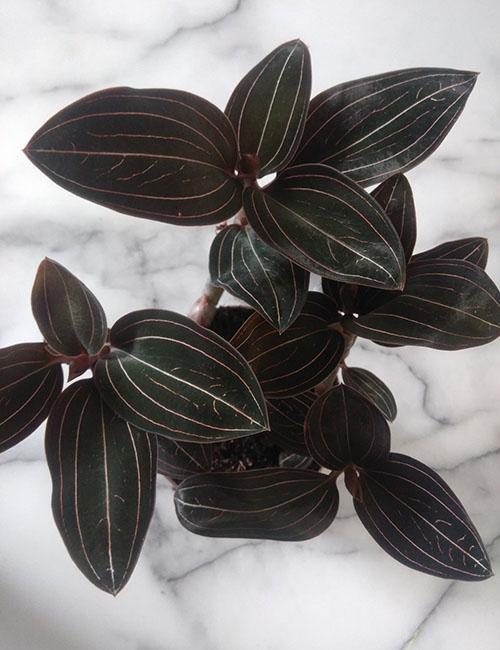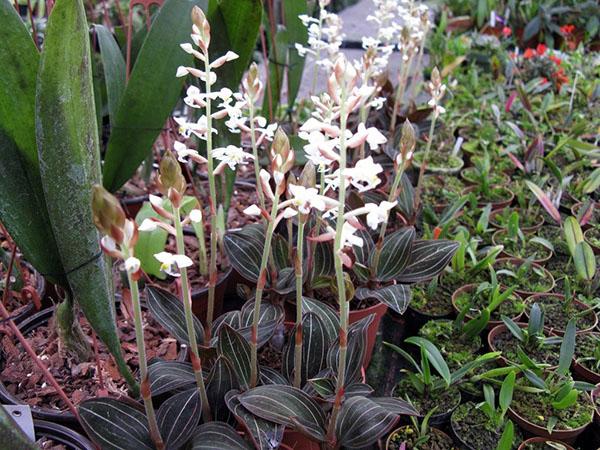Wonderful ludisia orchid: home care
 Each orchid in the florist's collection is a bright pearl, an object of admiration and special care. A real gem is the ludisia orchid, home care for which requires not only time, but also knowledge of a beautiful plant.
Each orchid in the florist's collection is a bright pearl, an object of admiration and special care. A real gem is the ludisia orchid, home care for which requires not only time, but also knowledge of a beautiful plant.
Most orchids are native to the subtropical and tropical regions of the globe. Ludisia motley, or Ludisia discolor - is no exception. A herbaceous plant native to Southeast Asia, it can be found in the wild in humid forests from southern China to Sumatra.
Description of orchid with striped leaves

Unlike many relatives who prefer the saprophyte lifestyle, the Ludisia orchid grows under the crowns, on a loose litter rich in humus.
The plant has thick juicy reddish roots. Numerous creeping shoots are covered with magnificent velvety leaves. They are the ones that attract the attention of everyone who sees the “precious” plant from the Orchid family for the first time.
The leaf plate is up to 7 cm long and up to 3.5 cm wide from the outside has a dark olive, sometimes almost black color. On the back, underside, the leaves are painted in a thick purple tone. Contrasting veins covering the entire leaf area, depending on the variety of ludisia, can be pinkish, silvery or light green.
 An adult orchid does not exceed 15–20 cm in height. Therefore, the appearance of peduncles up to 30 cm in height cannot be overlooked. However, flowering lasting about a month will not amaze connoisseurs. The inflorescence of an orchid with striped leaves consists of two or three dozen small nondescript whitish or yellowish flowers.
An adult orchid does not exceed 15–20 cm in height. Therefore, the appearance of peduncles up to 30 cm in height cannot be overlooked. However, flowering lasting about a month will not amaze connoisseurs. The inflorescence of an orchid with striped leaves consists of two or three dozen small nondescript whitish or yellowish flowers.
Conditions for growing ludisia orchids
 An orchid from a humid and shady tropical undergrowth requires the same conditions when grown indoors. The plant is most comfortable on the north, east or west windows. Here the sun comes only in the morning or evening hours, the rest of the time the flower is content with diffused light, which preserves the brightness and freshness of the foliage. The optimal length of daylight hours is 12-14 hours, so in the autumn-winter period they organize backlight orchids. On the southern windows, shading is organized for the plants or the pots are moved deep into the room.
An orchid from a humid and shady tropical undergrowth requires the same conditions when grown indoors. The plant is most comfortable on the north, east or west windows. Here the sun comes only in the morning or evening hours, the rest of the time the flower is content with diffused light, which preserves the brightness and freshness of the foliage. The optimal length of daylight hours is 12-14 hours, so in the autumn-winter period they organize backlight orchids. On the southern windows, shading is organized for the plants or the pots are moved deep into the room.
An excess of light can be judged by the drooping, oppressed leaves. The deficiency causes the creeping shoots to stretch out, and the leaves to shrink.
Temperature for caring for ludisia orchid at home:
- during daytime hours is 20–22 ºC;
- at night it can drop to 18 ºC.
 This mode allows the plant to maintain its tone, actively develop and bloom annually. If the weather permits, the flower pot can be taken out on a balcony or loggia, closed from the cold wind and direct sunlight.
This mode allows the plant to maintain its tone, actively develop and bloom annually. If the weather permits, the flower pot can be taken out on a balcony or loggia, closed from the cold wind and direct sunlight.
The flowering time is most often in late autumn, early winter or March. When the flower stalk withers, the orchid needs rest. For the period of implicit dormancy, it needs to be kept at a temperature of 18 ºC, the plant is kept moderately watered, and feeding is stopped.
Soil for ludisia and planting features
 For an orchid that naturally settles under the crowns of tropical trees and is accustomed to a rich, loose substrate, similar conditions are created at home. A transparent pot with drainage holes is filled with a mixture of equal parts of chopped pine bark, sphagnum moss and fern roots.They are supplemented with smaller pieces of birch charcoal, fertile leafy soil and grassland peat.
For an orchid that naturally settles under the crowns of tropical trees and is accustomed to a rich, loose substrate, similar conditions are created at home. A transparent pot with drainage holes is filled with a mixture of equal parts of chopped pine bark, sphagnum moss and fern roots.They are supplemented with smaller pieces of birch charcoal, fertile leafy soil and grassland peat.
So that the soil for ludisia provides nutrition to the plant, does not wash out of the pot during watering and is sufficiently moisture resistant, first large fractions are laid, then small ones. Sphagnum is used to compact the roots.
After planting, a young plant is watered so that the water:
- did not accumulate in the leaf axils;
- did not stagnate at the roots.
It should be remembered that caring for the ludisia orchid at home will be successful only if the air and substrate are moist.
To do this, you can:
- put the pot in a pallet with expanded clay and water;
- use humidifiers;
- spray the orchid with soft water from a spray bottle;
- sometimes bathe a green pet, except for varieties with velvety leaves, under a shower of warm water with a temperature of about 35 degrees, and then dry the leaves with a paper napkin.
For irrigation, use soft, settled water at room temperature.
 During the period of active growth and flowering, the ludisia orchid is fed. It is most convenient to combine this with watering. Special fertilizers for plants of this species are bred so that the concentration is two times lower than that recommended for flowering orchids.
During the period of active growth and flowering, the ludisia orchid is fed. It is most convenient to combine this with watering. Special fertilizers for plants of this species are bred so that the concentration is two times lower than that recommended for flowering orchids.
Reproduction and transplantation of ludisia
 At home, the plant does not need periodic replanting. The orchid is transferred to another pot if the previous one turns out to be small.
At home, the plant does not need periodic replanting. The orchid is transferred to another pot if the previous one turns out to be small.
At the same time, ludisia is provided with fresh fertile soil and the reproduction procedure is used:
- dividing an adult specimen;
- parts of the stem;
- apical cuttings.
The transplant of ludisia and the receipt of planting material are performed during the period of active growth, more often from March to June. At this time, the plant will be able to quickly recover, gain a foothold in the substrate and give a healthy growth.
 The easiest way to propagate a beautiful plant is with apical cuttings or cuttings with 2-3 nodes, dormant growth points and healthy aerial roots. The place of the cut on such a seedling is sprinkled with crushed coal, slightly dried. Then the seedling is rooted with sphagnum or in water with activated carbon.
The easiest way to propagate a beautiful plant is with apical cuttings or cuttings with 2-3 nodes, dormant growth points and healthy aerial roots. The place of the cut on such a seedling is sprinkled with crushed coal, slightly dried. Then the seedling is rooted with sphagnum or in water with activated carbon.
Sphagnum has good moisture capacity and bactericidal properties, which contributes to the early rooting of a young orchid.
For propagation of the Ludisia orchid using stem cuttings, they are cut from a strong adult plant. Moreover, each part must have at least 3-4 internodes. The leaves are carefully removed, the places of the cuts are sprinkled with charcoal powder, and the cuttings are horizontally squeezed into wet moss.
Diseases and pests of the ludisia orchid
 With competent and regular care, a flower with beautiful striped leaves demonstrates an unpretentious character. However, pests sometimes attack ludisia, and rot appears.
With competent and regular care, a flower with beautiful striped leaves demonstrates an unpretentious character. However, pests sometimes attack ludisia, and rot appears.
Sometimes wilting, loss of brightness and crushing of foliage provokes a lack of attention. Orchid should not be placed:
- near heating appliances;
- in a draft;
- in direct sunlight.
An obligatory element of caring for the ludisia orchid at home is the protection of the plant from pests and diseases. Excessive watering and insufficient drainage are the causes of root rot, which in most cases causes the death of the plant.
If the pot is brought into the balcony or open air, the orchid is threatened with acquaintance with pests. Most often people settle in Ludisia:
- spider mites;
- whitefly;
- mealybugs;
- scabbards;
- mushroom gnats.
To combat them, systemic insecticides are used for ornamental plants, and they also necessarily normalize plant care, restore correct watering, temperature and humidity conditions.